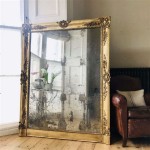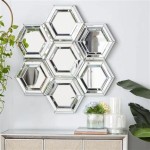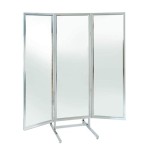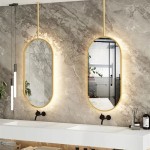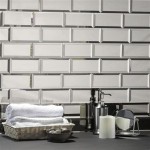Large Mirror Panels: Enhancing Spaces with Light and Dimension
Large mirror panels, increasingly favored by interior designers and architects, offer a powerful design tool for transforming spaces. Their ability to reflect light, create a sense of spaciousness, and add a touch of elegance makes them a versatile option for a wide range of applications, from residential to commercial settings. Understanding the characteristics, benefits, installation considerations, and potential drawbacks of large mirror panels is crucial for making informed decisions regarding their incorporation into any project.
The term "large" in the context of mirror panels is subjective and often depends on the specific application and manufacturing capabilities. However, panels that exceed standard mirror sheet sizes of approximately 48 inches by 96 inches are generally considered large. Advances in manufacturing processes have enabled the production of significantly larger panels, sometimes reaching sizes of over 10 feet in height or width, allowing for seamless wall coverings and dramatic visual effects.
The materials used to create large mirror panels are typically the same as those used for standard mirrors: a glass substrate, often float glass, coated with a reflective layer, usually silver or aluminum. This reflective layer is then protected by one or more layers of paint or other protective coatings to prevent corrosion and damage. The quality of these materials directly impacts the clarity, reflectivity, and longevity of the mirror.
Selecting the appropriate thickness for large mirror panels is paramount to ensure structural integrity and prevent distortion or warping. Thicker glass, typically ¼ inch or more, is often recommended for larger panels to minimize flex and maintain a flat, reflective surface. The specific thickness required will also depend on the installation method and the supporting structure.
Key Point 1: Maximizing Light and Space
One of the primary benefits of large mirror panels is their ability to amplify natural and artificial light within a space. By reflecting light sources, they effectively double the illumination, making rooms brighter and more inviting. This is particularly advantageous in areas with limited natural light or in environments where a brighter ambiance is desired.
Beyond simply reflecting light, large mirror panels also create a visual illusion of increased space. The reflection effectively extends the perceived boundaries of the room, making it feel larger and more open. This is especially useful in smaller spaces, such as apartments, hallways, or bathrooms, where maximizing the sense of spaciousness is a priority.
The strategic placement of large mirror panels can further enhance their impact on light and space. For instance, positioning a mirror panel opposite a window will maximize the amount of natural light reflected into the room. Similarly, placing a mirror panel along a narrow hallway can visually widen the space, making it feel less constricted.
The size and placement of the panel should be carefully considered in relation to the furniture and other elements within the room. A large mirror panel can become a focal point, drawing attention and adding visual interest to the space. However, it is important to avoid creating distracting reflections or unwanted glare that could detract from the overall aesthetic.
Consideration must also be given to what the mirror will reflect. A cluttered or unorganized space will appear amplified within the reflection, potentially diminishing the desired effect. Therefore, careful attention to the surrounding environment is crucial when incorporating large mirror panels.
Key Point 2: Aesthetic Considerations and Design Versatility
Large mirror panels offer a broad range of aesthetic possibilities, allowing them to be integrated into diverse design styles. From sleek and modern to classic and ornate, mirror panels can complement and enhance the overall décor. Their versatility stems from their ability to reflect and amplify the existing design elements within the space.
The use of tinted or colored mirrors can add further dimension and visual interest. Subtle tints, such as bronze or gray, can create a warmer or more sophisticated ambiance. Alternatively, bolder colors can be used to create a striking focal point or to complement a specific color scheme. The selection of a tinted mirror should be carefully considered in relation to the overall design intent and the existing color palette of the space.
Beyond their reflective properties, large mirror panels can also be customized with various decorative techniques, such as etching, sandblasting, or beveling. These techniques can add texture, pattern, and depth to the surface of the mirror, creating unique and visually appealing designs. Etched or sandblasted patterns can be used to create subtle accents or to incorporate personalized designs or logos.
The framing of large mirror panels can also significantly impact their aesthetic appeal. A simple, minimalist frame can create a clean and modern look, while a more ornate frame can add a touch of elegance and sophistication. The choice of frame material, color, and style should be carefully considered in relation to the overall design of the space.
Large mirror panels can be used in a variety of applications, including wall coverings, accent pieces, and furniture inlays. They can be incorporated into bathrooms, bedrooms, living rooms, hallways, and commercial spaces. Their versatility makes them a valuable tool for architects and interior designers seeking to enhance the aesthetic appeal of any environment.
Key Point 3: Installation Requirements and Safety Concerns
The installation of large mirror panels requires professional expertise and careful planning to ensure safety and structural integrity. Due to their size and weight, these panels can be challenging to handle and install, and improper installation can lead to damage, distortion, or even breakage.
Prior to installation, the wall or supporting structure must be thoroughly inspected to ensure that it is level, plumb, and capable of supporting the weight of the mirror panel. Any imperfections or irregularities in the wall surface must be corrected before the mirror is installed to prevent distortion or stress on the glass.
Adhesive bonding is a common method for installing large mirror panels, but it is crucial to use high-quality, mirror-safe adhesives that are specifically formulated to prevent damage to the reflective coating. The adhesive must be applied evenly and in sufficient quantity to ensure a secure and lasting bond.
Mechanical fasteners, such as screws or clips, may also be used in conjunction with adhesive bonding to provide additional support and security. The type and placement of fasteners should be carefully considered to avoid creating stress points that could lead to cracking or breakage. It is imperative that the fasteners are concealed to maintain the aesthetic appeal of the installation.
Safety is a paramount concern during the installation of large mirror panels. Workers should wear appropriate personal protective equipment, including gloves and eye protection, to protect themselves from cuts and other injuries. Proper lifting techniques and equipment should be used to handle the heavy panels safely and prevent accidental drops or breaks.
In some cases, it may be necessary to reinforce the wall or supporting structure to ensure that it can safely support the weight of the mirror panel. This is particularly important in older buildings or in areas that are subject to seismic activity. A structural engineer should be consulted to assess the structural integrity of the wall and to recommend any necessary reinforcements.
Consideration should also be given to the potential for thermal expansion and contraction. Large mirror panels can expand or contract slightly due to changes in temperature and humidity. Therefore, it is important to allow for sufficient expansion joints or gaps around the edges of the panel to prevent stress and potential cracking.
The final installation should be carefully inspected to ensure that the mirror panel is securely attached to the wall and that there are no signs of distortion, stress, or damage. Any imperfections or issues should be addressed promptly to prevent further problems.
The environmental conditions within the space should also be considered. High humidity levels can accelerate corrosion of the reflective coating, particularly in bathrooms or other areas with frequent moisture exposure. Proper ventilation and the use of moisture-resistant sealants can help to prolong the lifespan of the mirror panel.
Regular cleaning and maintenance are essential to keep large mirror panels looking their best. Use a soft, lint-free cloth and a mild glass cleaner to remove dust, fingerprints, and smudges. Avoid using abrasive cleaners or scouring pads, as these can scratch the surface of the mirror. With proper care and maintenance, large mirror panels can provide years of enjoyment and enhance the beauty of any space.

Interior Living Room Wall Panels Livingroomwallpanels Mirror Decor Mirrors

Wall Mirror Design 8 Decorative Mirrors To Transform Your Home

Mirror Walls And Tiles Mirrorworld

10 Mirror Wall Panel Design Ideas Catalogue Know Cost Saving Tips

All Glass Modern 8 Panel Tray Design Wall Mirror 216 X 106 Cm 8ft1 3ft6

Decorative Mirror Tiles On The Wall Decor Living Room Bedroom

Mirrored Tiles Mirrorworld

Mirror Wall Panel Supplier Manufacturer Delhi Ncr

Venetian 4 Panel Mirror Bevelled Edge Panels Glam Decor

Pvc And Mirror Wall Panels Rectangular Decorative Home Simple Sku Wbmr Denmark
